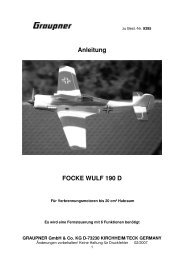Graupner New Items 2008
Graupner New Items 2008
Graupner New Items 2008
You also want an ePaper? Increase the reach of your titles
YUMPU automatically turns print PDFs into web optimized ePapers that Google loves.
2.4 GHz <strong>Graupner</strong> IFS system<br />
2.4 GHz <strong>Graupner</strong> IFS system<br />
Bi-directional, modular radio<br />
control system with intelligent<br />
frequency hopping process<br />
IFS - Intelligent Frequency Select<br />
Here we have a further milestone from<br />
<strong>Graupner</strong>’s RC development department.<br />
Just replace the RF module and<br />
receiver, and your radio control<br />
system immediately switches to the<br />
2.4 GHz band with its inherent security<br />
of transmission. The new <strong>Graupner</strong><br />
IFS system is the result of several<br />
years of development work. Intensive<br />
practical testing has proceeded in<br />
parallel with the development phase,<br />
and this has confirmed the basic<br />
design concepts. The advantages<br />
speak for themselves:<br />
● In a matter of seconds you transform<br />
your previous 35 MHz or<br />
40 MHz system into a <strong>Graupner</strong> IFS<br />
system, working in the 2.4 GHz<br />
band. None of your transmitter<br />
settings are lost!<br />
● Bi-directional communication between<br />
transmitter module and the<br />
connected receiver. The data is<br />
transmitted and confirmed in fractions<br />
of a milli-second – in both<br />
directions!<br />
● Short, sharp pulsed signals effectively<br />
suppress possible interference<br />
signals.<br />
● The modular nature and backwards<br />
compatibility of the system make it<br />
possible to install the modules even<br />
in older systems - right back to the<br />
<strong>Graupner</strong> FM-6014 transmitter!<br />
● 120 models can be operated<br />
simultaneously.<br />
● If interference occurs, an intelligent<br />
frequency hopping process<br />
(registered patent) initiates a<br />
channel switch-over procedure.<br />
The transmitter and receiver<br />
modules switch over simultaneously<br />
– while the model is operating<br />
– and the user notices absolutely<br />
nothing.<br />
134 <strong>New</strong> <strong>Items</strong> ’08<br />
● After the binding process the receiver<br />
does not respond to any<br />
other transmitter signal, i.e.<br />
“channel clashes” – two transmitters<br />
on the same frequency –<br />
are eliminated at the system level.<br />
● Fail-safe functions can be programmed<br />
individually for each servo<br />
channel at the receiver: hold last<br />
position / run to individually programmed<br />
position. Fail-safe times<br />
can also be set to cope with catastrophic<br />
failure, e.g. transmitter<br />
battery collapse.<br />
● Individual servo channel assignments<br />
are possible at the receiver.<br />
● The transmitter output power is<br />
variable over several increments<br />
from 10 mW (approved all over the<br />
world) to 100 mW. Please check<br />
your national regulations before<br />
using the system!<br />
● The current drain is extremely low;<br />
even when set to maximum transmitter<br />
power the RF module draws<br />
less than 90 mA, which means that<br />
you can obtain much longer operating<br />
times whilst retaining your<br />
existing transmitter battery.<br />
● Data encoding and 64-bit error<br />
detection make it virtually impossible<br />
to send incorrect or invalid<br />
data to the servo outputs.<br />
● The 16-bit system provides a resolution<br />
of 65,536 steps, and this is<br />
available at the servo channels. The<br />
result is that your model responds<br />
more directly and with finer control<br />
to transmitter commands.<br />
● Special aerial technology eliminates<br />
the need for different aerials which<br />
respond to phase shifts or reflections.<br />
● Frequency conflicts and waiting for<br />
the frequency peg are now a thing<br />
of the past.<br />
● The system eliminates the need to<br />
set channels using the Synthesizer<br />
system, or physically to change<br />
plug-in crystals.<br />
● You have complete control over the<br />
model for as long as you can see it.<br />
● Real-time telemetry transmission<br />
from model aircraft, helicopter, car<br />
and boat: in preparation.<br />
Specification<br />
Range (six-channel receiver)<br />
– Up to 150 m on the ground *)<br />
with visual connection<br />
– Up to 500 m in the air with visual<br />
connection<br />
Range (six / ten / twelve-channel<br />
receivers)<br />
– Up to 800 m on the ground *) with<br />
visual connection<br />
– Up to 2000 m in the air with visual<br />
connection<br />
*) Ground range = »model standing in grass«<br />
Frequency<br />
– 2.4 GHz ISM band, intelligent<br />
frequency hopping process.<br />
– Approximately spherical Radio<br />
Frequency radiation characteristic,<br />
eliminating the need for multiple<br />
aerials.<br />
Resolution<br />
– 16 bits per channel (65,536 steps).<br />
– +/-10 ns servo signal accuracy.<br />
Susceptibility to interference<br />
– Chance of being on the same<br />
frequency as another module:<br />
1 in 18,446,744,073,709,552,000.<br />
– Up to 120 models can be operated<br />
simultaneously.<br />
Aerial length<br />
– Six-channel receiver: integral aerial.<br />
– 3 cm receiver aerial, completely<br />
enclosed in the case.<br />
– Transmitter: external aerial, approx.<br />
12 cm long.<br />
Additional features<br />
– Individually programmable<br />
Fail-Safe function for each channel.<br />
– Programmable servo channel<br />
assignment.<br />
– Bi-directional telemetry data<br />
interface.<br />
(exception: six-channel receiver).<br />
For further information on the<br />
„Connection of the Future“<br />
please have a look at<br />
www.graupner-ifs-system.de

















